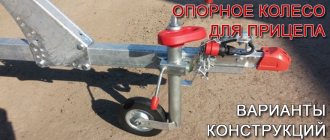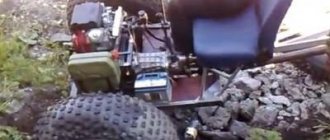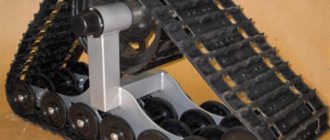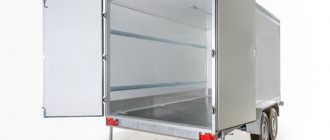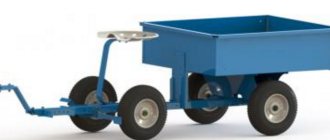How to easily make a trailer axle with your own hands
We will send the material by email
With the recent acquisition of a summer cottage, the need arose to visit it frequently. Every weekend, if not more often, I had to go to the dacha to fix, change, do something. This required a lot of equipment and various things. I wouldn’t be able to carry even half of everything in my old Nissan. So I decided to make a homemade trailer. I’m recording the whole process, I want to tell you everything and show you. I already have the frame and wheels ready, so now I’ll tell you how I made my own axle for the trailer. Maybe it will help someone.
DIY axle for a car trailer
Useful tips. Axle for a passenger trailer: types, how to make it yourself. Hubs for passenger trailers and trailers with a total weight of 3.5 tons. How to make a passenger trailer axle from a Zhiguli hub. Axle for a trailer, axle for a trailer, buy an axle for a passenger trailer, price. How to make a trailer for a walk-behind tractor with your own hands: diagrams, drawings
VIDEO ON THE TOPIC: Why the trailer AXLE BENDS // Chernak
Dear readers! Our articles talk about typical ways to resolve legal issues, but each case is unique.
If you want to find out how to solve your particular problem, please use the online consultant form on the right or call the numbers provided on the website. It's fast and free!
- How to make a trailer axle with your own hands
- Axle for a passenger trailer: types, how to make it yourself
How to make a trailer axle with your own hands
Useful tips. Axle for a passenger trailer: types, how to make it yourself. Hubs for passenger trailers and trailers with a total weight of 3.5 tons. How to make a passenger trailer axle from a Zhiguli hub Axle for a trailer, axle for a trailer, buy an axle for a passenger trailer, price How to make a trailer for a walk-behind tractor with your own hands: diagrams, drawings Axle for a hub with your own hands without a lathe - .
A little about the axle, suspension and hubs
You can buy a ready-made axle, but if you are here and reading this, you understand that a homemade trailer axle will cost much less, you will get a general idea of the work of the axle and, possibly, pleasure.
The axle itself is a simple suspension element, but in fact it is a pipe, which can be square or round.
If we compare the strength of these two types of axles (with the same wall thickness), then the square one is naturally better. However, axes with a square section are not used in everyday life. Since they are more expensive, both to purchase/produce and to maintain.
When you buy an axle, it comes with hubs, which often come with brakes. But if you assemble the axle with your own hands, then you will have to connect them to the axle with your own hands. Therefore, you should know that hubs come in two types:
- Block (more reliable, durable, but also expensive);
- Chamomile (they are simpler, less reliable, and, naturally, cheap);
Since you don't have to take them apart when replacing hubs, this makes trailer maintenance easier. In this regard, the chamomile type of hubs is popular.
There are two ways to connect the hub to the axle - welded or bolted.
Welding the hub to the axle is a more reliable method, but if the hub breaks and there is a need to replace it, it will be extremely difficult to remove it.
There are two types of pendants:
Torsion bar models are more in demand, which is easily explained, because they:
- durable;
- extremely easy to use;
- compact and weigh relatively little;
- they also do not need shock absorbers;
The torsion bar suspension is rigidly connected to the frame. It consists of an empty pipe (polygonal), inside which is exactly the same, but of a smaller diameter, which also serves as an internal shaft, and the wheel is attached to it. The smaller pipe is wrapped with rubber gaskets (bundles) so that all the empty space between the pipes is filled with them.
Torsion bar suspensions are suitable for use in the city and on asphalt roads.
Spring suspensions are stiffer and more resistant to loads. Such suspensions are suitable for use in normal and extreme conditions. The disadvantage of this type is that it is more expensive and requires maintenance.
Wheel hubs for light trailers
I’ll warn you right away - this is a very boring post!))) But this is usually for those who are not in the know or who don’t need it. At the same time, I think there will be those gourmets who will read it with pleasure and will learn something for themselves!)) I will be glad to receive comments. Amendments. Comments!) Well, whoever has more information - share!) And whoever is interested - please repost. It won’t hurt you, but I’m pleased, and you’ll earn a return for your karma!)
Now about the domestic industry. In any case, I really want to hope so, that it has begun to revive! Why are we worse? After all, they were once strong and powerful! It's time, it's time... In short, a representative of a supplier from the Penza region came to see me yesterday. I brought my products. The day before there was a telephone conversation, and the next day he was already in Nizhny Novgorod - 500 km! With samples! Great! Honor and respect! I brought a ready-made hub assembly for the manufacture of spring axles for trailers. And it turned out quite well! Plus optional and interchangeable! Well, the price. Patriotic! This is what I understand! I've been monitoring this topic before. I was thinking about taking on this kind of thing myself. To squeeze out foreign suppliers a little, so to speak... I was working on mold casting. I outlined the hub.
Then I sent requests to possible suppliers:
I received answers... But. Any direction takes time (or rather, you need to devote a lot of it to it). Well, investments. Having received the information, I analyzed the final price tag. I was not very impressed with it in terms of the difference from buying imported ones. Therefore, I put this project aside.
And then Samara appeared on the horizon with its proposals. I was very impressed. And their assortment is quite good - as many as 4 varieties differing in outer diameter 117,133,140,182, bolt pattern (4x98 and 5x139.7) and, accordingly, bearings. Starting from 140 and on 182mm hubs they install the front VAZ one (34mm fit). The other two are rear mounted, with a 30mm fit. And the price is reasonable compared to imported ones. So I got hooked on them. These are the options:
The process of assembling an axle for a passenger car trailer
At this point, if you want to assemble a trailer axle, you should already have the frame and wheels ready. The sequence of actions is as follows:
- Choose a beam (with a round or square cross-section, whichever you like best);
- Next, connect the hub axle with fasteners using bolts or welding to the already selected beam. The hub should fit into the main pipe by about a couple of millimeters;
- If your trailer is single axle, then install the axle at a distance that is 40% of the length of your trailer from the tailgate. At this stage, measurements must be made with maximum accuracy;
- Then turn the trailer over so that the bottom is on top and make sure that the spindles are not in the way;
- The axle installation site must be thoroughly cleaned. Next, measure and divide the distance between the bushings by two, then make marks;
- Connect the axle to the frame by spot welding along the entire contacting surface;
The assembly process is complete. All that remains is to mount the sides with wheels.
It should also be clarified that in addition to spring and torsion bar suspensions, you, like many craftsmen, can install a spring-shock-absorbing suspension on your just-made trailer, which provides a much softer ride.
Self-assembly of the structure
Let's assume that you already have a trailer frame and have chosen your trailer wheels.
Now you need to figure out how it all comes together and turns into a full-fledged axle as a structural element of your car trailer. Let's look at a few key steps.
- To begin with, the beam itself is selected. It doesn't matter whether it has a round or square cross-section. The main thing is that you take the appropriate dimensions and use high quality metal. Otherwise, the suspension will not last long;
- Next, we take the hub axle, on which the hub itself will be installed, and connect it to the pipe. How to connect these two elements? It will be ideal if the hub axle fits at least a few millimeters with its protrusion inside the pipe. Here, a round section has a better chance than a square one. Then it’s all welded or bolted together. Learn from Kurgan trailers if you want to make a collapsible model. If not, just weld the elements together efficiently. This is done on both sides;
- Now you have a full-fledged axle ready, to which a spring or torsion bar will then be mounted;
- According to current rules, the trailer axle is mounted to a length corresponding to 40% of the total length of the trailer on the rear side;
- Make the replacements accurately, mark the location for your axle;
- It is better to perform installation from above, that is, the trailer will have to be turned over and placed on a flat surface. Make sure the spindles hang freely and do not interfere with your work;
- Clean the area of the frame of the future trailer where you will mount your axle. Measure the distance between the bushings and divide into two equal parts. Don't forget to mark everything with a marker on the axis;
What's the result?
Today we looked at how to make an axle for a car trailer. To do this, we needed, in addition to the frame and wheels, which were already available, a beam with a round or square cross-section, a hub and tools (welding, tape measure, marker and others).
First, we connected the hub axle to the beam by bolting or welding. At the same time, they connected it so that the hub pipe entered the main pipe by a few millimeters.
Afterwards, we turned the trailer over, measured the distance of 40% of the length of the trailer from the rear side, cleaned this place, and connected the axle to the frame in this place by spot welding.
Write in the comments what you think - which type of suspension is more reliable - leaf springs or torsion bars?
Source
Drawing of axle for trailer hub VAZ 08
Hi all! In our country there are many craftsmen who prefer to do everything with their own hands. Some even assemble the axle for a light trailer themselves. That’s why we’ll talk about this topic today.
Before you start assembling an element of your trailer for passenger cars, I advise you to decide on the choice of design. They are different, which introduces some differences into the device.
With a little work on the hub, springs, shock absorbers and other components, you can get an excellent homemade axle, and a trailer with dependent or independent suspension will perform no worse than the factory models.
Design options
For some, it is easier to order a ready-made axle rather than assembling something yourself. But if you know how to do it or want to understand how all this is made with your own hands, I suggest you simply buy or find the appropriate parts and assemble a full-fledged axle from them.
But which one? The trailer axle, as a suspension element, is just a pipe. It comes in two types, depending on the cross-section:
If we take identical parameters of wall thickness, cross-sectional area and diameter, then the square versions will require more effort to bend. That is, they are stronger than round ones.
Also, the assembled axle comes with a hub and brakes (not everywhere). Mainly 2 types of hubs are used:
The price and repairability are better for the chamomile, although the block hubs are more reliable and durable at a higher price. They can only be replaced as an assembly. I don’t see anything bad here, since it simplifies the replacement procedure and maintenance of the trailer.
The hubs are welded or screwed. The latter connection method is actively used on Kurgan trailers. Accordingly, between a welded and prefabricated structure, I would give preference to the latter due to a simpler approach to repair and maintenance. But it's up to you.
On trucks and, less commonly, on passenger cars, trailers can come with a swivel axle, where the entire axle rotates along a vertical axis using a kingpin turntable.
The suspension or axle used on caravans is:
- torsion bar (with and without brakes);
- spring (with and without brakes).
We will look at them in more detail.
Spring and torsion bars
Torsion bar models are now very in demand and popular. This can be explained by objective advantages:
- serve for a long time;
- no difficulties in operation;
- simple maintenance;
- it is not necessary to use shock absorbers;
- are small in size;
- the space between the axle and the frame is reduced;
- have a small mass;
- These are designs with independent suspension at the trailer wheels.
Torsion bar or rubber harness structures are equipped with a rigid fastening to the frame. There is a polygonal pipe mounted to a frame, inside of which there is a pipe of a similar shape, only with a smaller diameter. The free space between them is filled with special rubber bands. They make it possible to ensure the immobility of the inner tube connected to the wheel.
I would not buy such a suspension among used options. Used or used ones already have a noticeably reduced service life, since the long service life directly depends on the condition of the harnesses.
Axle for a passenger trailer: types, how to make it yourself
Hi all! In our country there are many craftsmen who prefer to do everything with their own hands. Some even assemble the axle for a light trailer themselves. That’s why we’ll talk about this topic today.
Before you start assembling an element of your trailer for passenger cars, I advise you to decide on the choice of design. They are different, which introduces some differences into the device.
With a little work on the hub, springs, shock absorbers and other components, you can get an excellent homemade axle, and a trailer with dependent or independent suspension will perform no worse than the factory models.
Design options
For some, it is easier to order a ready-made axle rather than assembling something yourself. But if you know how to do it or want to understand how all this is made with your own hands, I suggest you simply buy or find the appropriate parts and assemble a full-fledged axle from them.
But which one? The trailer axle, as a suspension element, is just a pipe. It comes in two types, depending on the cross-section:
If we take identical parameters of wall thickness, cross-sectional area and diameter, then the square versions will require more effort to bend. That is, they are stronger than round ones.
Also, the assembled axle comes with a hub and brakes (not everywhere). Mainly 2 types of hubs are used:
The price and repairability are better for the chamomile, although the block hubs are more reliable and durable at a higher price. They can only be replaced as an assembly. I don’t see anything bad here, since it simplifies the replacement procedure and maintenance of the trailer.
The hubs are welded or screwed. The latter connection method is actively used on Kurgan trailers. Accordingly, between a welded and prefabricated structure, I would give preference to the latter due to a simpler approach to repair and maintenance. But it's up to you.
On trucks and, less commonly, on passenger cars, trailers can come with a swivel axle, where the entire axle rotates along a vertical axis using a kingpin turntable.
The suspension or axle used on caravans is:
- torsion bar (with and without brakes);
- spring (with and without brakes).
We will look at them in more detail.
Spring and torsion bars
Torsion bar models are now very in demand and popular. This can be explained by objective advantages:
- serve for a long time;
- no difficulties in operation;
- simple maintenance;
- it is not necessary to use shock absorbers;
- are small in size;
- the space between the axle and the frame is reduced;
- have a small mass;
- These are designs with independent suspension at the trailer wheels.
Torsion bar or rubber harness structures are equipped with a rigid fastening to the frame. There is a polygonal pipe mounted to a frame, inside of which there is a pipe of a similar shape, only with a smaller diameter. The free space between them is filled with special rubber bands. They make it possible to ensure the immobility of the inner tube connected to the wheel.
I would not buy such a suspension among used options. Used or used ones already have a noticeably reduced service life, since the long service life directly depends on the condition of the harnesses.
Plus, rubber harness models are not suitable for active use in harsh conditions. This is an option for those who intend to operate the trailer mainly around the city and on relatively smooth asphalt.
If the operating conditions are harsh, then it makes sense to make or buy a spring-type axle that is more resistant to loads. It is not afraid of serious overloads due to the longer stroke length compared to its torsion bar counterpart. But keep in mind that you will have to take care of the spring suspension more carefully and more often.
The spring, as well as the torsion, variation of the axle is available in Voronezh, in Belarus, it can be bought in Moscow, St. Petersburg, or contact Chelyabinsk or Kyiv. It doesn't matter so much where you live. Now the width of the assortment is so limitless that ordering an assembled pendant or components for self-production is not difficult.
I already wrote about leaf spring suspension HERE, so I advise you to follow the link and read it.
